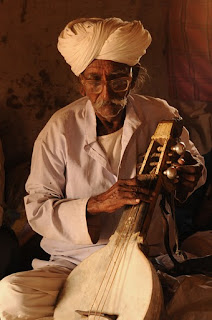 Once seduced by the Manganiyars, Roysten Abel is now taking them to audiences around the world, writes Shivangi Ambani-Gandhi
Once seduced by the Manganiyars, Roysten Abel is now taking them to audiences around the world, writes Shivangi Ambani-Gandhi One of the most eagerly anticipated acts as part of the Sydney Festival 2010 is a show by the Manganiyars, a caste of Muslim musicians from Rajasthan. Their performances are nearly sold out and new shows had to be added to meet demand. You may be surprised, but director Roysten Abel is not—even when, after viewing Manganiyar Seduction, members of the audience often walk up to thank him for showing them God. “I am not surprised by the response, because that is how I felt when I first saw the Manganiyars.”
About 10 years ago, Abel saw a traditional concert by the Manganiyars and the experience lingered and in 2006 he included two musicians in one of his theatre performances in Spain. He had to leave this show mid-way to be in Germany for another performance.
“However, I felt myself wanting to hear more of their music. I called them up and made them play to me over the phone,” recollects Abel. “I knew then that I had been totally seduced by the music and wanted to translate it into a more physical form.” So rather than use music in theatre, Abel reversed the process by using theatre to create theatre in music.
In this production, 43 Manganiyars perform seated in 36 boxes, inspired by the windows of the famous red light district of Amsterdam—one he describes as being extremely theatrical and burlesque. “I loved the theatricality of it. The soul is seduced through the body and so I wanted to marry the two.”
Each box is curtained and framed by carnival lights. A single voice emerges, as the curtains on one cubicle are drawn. Soon the other cubicles light up, as a range of musical instruments—including the Khamacha (string instrument), Kartal (percussion instrument similar to the Spanish castanas) Sindhi Sarangi and Murli (snake charmer's flute, also called been)—and the voices of men, women, children and the elderly of the Manganiyar community, build up a spectacle of rhythm and song.
Adding to the theatricality of the performance is an animated conductor. “Traditional Indian musical performances don’t have a conductor. I found the conductor of Western Classical performances very theatrical and wanted to incorporate that aspect. The conductor is a rehearsed act. Besides, there is also the practical aspect that he has the entire crew of musicians to pull through the show,” says Abel.
M
Besides theatre and music, Abel has also worked in film. “While film is quite different and has its own technique, I do want there to be a synergy in all my art forms. I was hoping that there is a space where they can all go together.”
Breaking out of conventions is nothing new to Abel, right from the time he dropped out of his commerce class, discarded the family business and joined drama school—informing his parents only after he had taken admission.
“Theatre was not, and still is not a career in India,” says Abel. “I did not think about how I would sustain myself or a family, I just did it because I loved theatre. That is how my productions are as well—I have an idea, and I pursue it not quite knowing how the logistics will work out, but things just seem to fall into place.”
He does of course have a couple of big ideas up his sleeve at the moment. The first, a major production with Manganiyar musicians, titled The Manganiyar War that will interpret the 10 days of the war from the Mahabharata through music. “I hope to interpret the atmosphere and mood of the war through the quality of singing,” says Abel.
The musicians you hear singing soulful ballads and Sufi poems hardly seem like the voices of rage or violence, I say. “They have an aggression between the musicians,” explains Abel. “Just as there is jugalbandi, there is also jangbandi where a musician tries to outdo the other.”
Abel’s
He is passionate about India’s traditional resources and has worked with various folk and street artists including magicians, jugglers, impersonators, snake charmers, and puppeteers. “I grew up listening to the usual rock music. It was just 10 years ago that I was exposed to folk music and discovered a different side of India and it was absolutely fantastic,” he says. “I delved deeper into the various cultures of India and knew I had to work in this world.”
The Manganiyars are not the only folk artists that have been successfully received by audiences the world over—Tim Supple’s A Midsummer Night’s Dream was performed with folk musicians and acrobats from across India. Meanwhile, Underscore Records, established by Shubha Mudgal and Aneesh Pradhan, gives Indian musicians access to the global market through an online store. The magic of Indian folk traditions is certainly making inroads into the global arts scene.
All photos by Wolfgang Krichner
No comments:
Post a Comment